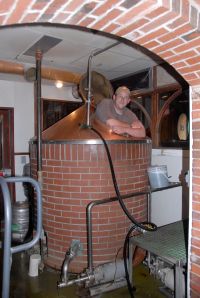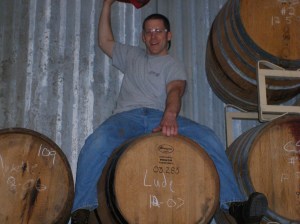 I met Ben in the basement of Gritty’s, where I found him cleaning the pub lines. You know right away that Ben’s a hands on brewer, and is involved with every part of getting the beer to Gritty’s customers. Ben was running BLC though the lines, and after flushing them, he hooked the beer back up.
I met Ben in the basement of Gritty’s, where I found him cleaning the pub lines. You know right away that Ben’s a hands on brewer, and is involved with every part of getting the beer to Gritty’s customers. Ben was running BLC though the lines, and after flushing them, he hooked the beer back up.
“This is the only time I ever have to dump beer. I hate to do it, but it’s the only way to clean the lines.” Ben says.
I spent the better part of an hour shadowing him through various tasks, taking gravity and temperature readings of 2 different batches of fermenting beer, and watched him decide whether or not to cool them down with a hit of glycol. At Gritty’s, there’s no automatic temperature control. Ben turns the glycol on and off, and makes mental calculations about how much to cool the fermentation down in order to have the beer finish on a normal work schedule. Gritty’s uses traditional English brewing methods, designed and installed by Alan Pugsley.
Ben has a 4’x5′ whiteboard in the hallway, where he makes notes for himself throughout the workday. It contains sketches of the volume of beer left in each of their serving tanks, as well as the brewing schedule for the upcoming 7 days, along with notes about temp, gravity and finishing times of the 4 actively fermenting batches of beer.
After Ben is satisfied that he can take a break, we sit down and begin to talk about how he came to be here.
How did you first get started in brewing?
I started home brewing with extract with a friend of mine, about 10 years ago… a little more than that now I guess, and pretty quickly got really into it, switching to all grain. I was in grad school at the time, so I had a lot of free time. Well, it wasn’t really free time, but I used it as free time, and brewed a lot. I reached a point at one time where in my basement I had 19 beers fermenting and conditioning at once.
What was your primary interest in home brewing, did your friend pull you into it? Was it an interest in a certain kind of beer?
It was more a scientific curiosity… I was always into drinking good beers, even from before it was legal for me to do that. I think the first beer I ever drank was Old Milwaukee’s Best or something, but I pretty quickly discovered Guiness and other better beers – whatever was available then, which was Guiness, Bass, Anchor Steam (which i still love to this day). My friend and I were tasting a lot of good beers together at that time, and thought “I bet we could learn a lot more about this if we made some ourselves.” And we did.
Was Guiness the standout as the first non-macro lager that appealed to you?
Yes, probably. and it was Guiness Extra Stout, which I think is a really under-appreciated beer. The Guiness pub draft stuff is what it is, but I think that the Extra Stout is possibly one of the best extra stouts out there. That was the first really good beer I had. The other one that stands out to me is the first belgian style beer I had: Le Fin Du Monde. I had that when I was camping in Quebec City in 1992 or so, it was shortly after that beer came out, and I had never had a belgian style beer before. It tasted really good and interesting, and I had about 2 and realized I was getting percent tipsy, and looked at the bottle and said “Wow, 9%?” From then on I’ve been a fan of Belgian beers, not because they’re high in alcohol, but because they’re just really good.
What is a typical workday for you, how does it start?
It starts for me at 7, I get in here, and start heating the water, adding whatever minerals I need for that batch, and I’m usually done mashing in about 45 minutes after walking in the door, so the morning goes pretty fast.
So you spend the majority of your workdays brewing?
Oh yes, especially in the summer, I spend almost every day brewing. In the winter, since we’re not quite as busy, things get spaced out a little more, which gives me time to get caught up on all the things I haven’t had time to do.
Whats your favorite piece of equipment here in the brewery?
The auger is kind of a cool piece of equipment, but there’s a little warning sign on it, which makes me smile just about every day when I see it. It shows the guy with his foot being severed and falling back with his foot stuck in the screw. It’s one of those pictograph things that whoever came up with the artwork was smoking something. So yeah, that craks me up almost everyday. Also, the open fermenters are also still really neat to me. I had never actually seen one until I began working at Gritty’s, and they’re still really neat to me in how they work. Most breweries, their tanks are closed, and while you know what’s going on in there, it’s still really cool to get to see it in the open tanks.
Yeah, I get that. I still check on my carboys with every batch of homebrew I make, and uncover them to see what’s going on.
Oh yeah totally. I’ve made these boxes for my carboys and will take a flashlight in there to see what’s going on.
Yesterday I brewed an IPA, and before I went to bed last night I thought to myself “Well I bet that beer’s fermenting by now” and I found myself imagining what it would look like. And then every morning when I come in here the beer I made the day before is going nuts, and you can see why centuries ago people used to think that it really was magic how beer was made.
Is there a piece of equipment here that you wish you did have?
Yeah, I wish I had a CO2 meter installed. That would be really nice. And a slightly more automated and less manual keg cleaner.
Cool, I think that says a lot about how involved you are in all the different facets of the brewpub here, as opposed to just running the mash tun and the boil kettle.
That’s one of the really nice things about working here at Gritty’s as opposed to a big brewery where on any given day you’re only touching once piece of equipment, either brewing or packaging, and on any one day, you’re probably only doing one task, while here, I’m doing a little bit of everything every day. There’s brewing, transferring, cellaring operations, kegging. It never gets boring at all. Plus I’m doing a lot of maintenance myself too.
Have you worked anywhere else?
I started at Gritty’s in Freeport, which their system is pretty much is the same as ours, but their system is twice as big as ours here. They do all the draft beer sales, and they do some of the bottling. So up there I got experience with filtration and packaging. It was a good place to get started.
What’s your favorite kind of beer to brew?
Every time I get interviewed I get asked that question (laughs). It’s a really tough question. I guess that here, my favorite beer that I’ve brewed was a smoked porter. I was really happy with how that turned out. At home, I usually don’t do any of the crazy homebrewing stuff, I work a little more traditionally, but one time I did make a poblano pepper (belgian) wit beer, and that came out really good. I made it for my wife, not for myself, but I ended up really liking that one too. The one I brew the most and love every time is a czech pilsner. I really love a good pilsner.
Is that a recipe that’s from a book, floating around, or is it your own recipe?
It’s my own recipe, I made it from the ground up. I use mostly german pilsner, acidulated malt, a little bit of cara pils. Mostly czech saaz, and I’ve played around with using some american hops for late additions. When I taste it, I don’t use enough of the american hops to make it really noticeable, but you can tell that there’s something going on there. I use the Pilsner Urquell H yeast strain. I’ve used a number of yeast strains, and that’s my favorite.
What’s your favorite food to pair with that beer?
That’s another tough question. I’m really into food and beer pairings, but that beer isn’t the most interesting with food for the most part. it’s really good with german or swiss cheeses, like Emmental, or Gruyère, it’s nice with those. it’s also really good with a german sausage, like bratwerst and sauerkraut. It goes well with something heavy and fatty, it cuts through well.
Do you cook with it at all?
No, it’s a little bit too hoppy to cook with. I’ve found that when you cook with hoppy beers, when you cook them down they get really bitter. When i cook with beer, I usually cook with a wheat beer or a maltier german beer, like an octoberfest. I have cooked with the hoppier beers, and almost never like how it comes out. I do have a recipe for a spinach casserole with a czech pilsner, and that comes out well.
Anything else abut yourself or your personal learning experience that you’d like to share?
The one thing that comes to mind, when I went to brewing school, I learned a lot about the science, and I’m really glad that I did, because I use that knowledge every day. but what I really love about brewing, is that you don’t have to know the science side to brew, and you also don’t have to be an artist to brew, you can do it with pure science. But if you have both, that’s when you can make really outstanding beer. i’m not there yet, but that’s what I’m striving for. I’ve been doing it for over 10 years, and it doesn’t seem like I’m anywhere close to being sick of it yet.
Here’s the recipe for Czech Pilsner with an American Twist (all-grain recipe for 5 gallons):
 Note: This recipe is highly dependent on soft water, so if yours is high in minerals I strongly recommend diluting or substituting with distilled water. Portland’s water is very soft, so I add either a few ounces of acidulated malt or 15 mL lactic acid to the mash.
Note: This recipe is highly dependent on soft water, so if yours is high in minerals I strongly recommend diluting or substituting with distilled water. Portland’s water is very soft, so I add either a few ounces of acidulated malt or 15 mL lactic acid to the mash.
Grain:
9# German Pils malt
0.5# Munich malt
0.5# Caramel Pils malt
0.75# Carapils malt
Hops:
Crystal Whole Flower (or other noble variety), 4%AA, 1 oz, added first wort
Saaz Pellets, 3.9%AA, 1 oz, boil 60 min
Saaz Pellets, 3.9%AA, 1 oz, boil 20 min
Saaz Pellets, 3.9%AA, 1 oz, boil 5 min
Summit Pellets, 18.5%AA, 0.5 oz, boil 5 min
Saaz Pellets, 3.9%AA, 1 oz, boil 1 min
Summit Pellets, 18.5%AA, 0.5 oz, boil 1 min
Saaz Pellets, 0.5 oz, dry hop in secondary (lagering) vessel
Summit Pellets, 0.5 oz, dry hop in secondary (lagering) vessel
Yeast:
WYeast 2278 Czech Pils – I strongly recommend making a very large starter for this beer (as for all lagers). I typically make 1.5 gallons of starter well in advance, then decant the beer before adding the slurry to the wort.
Other ingredients:
1 Whirlfloc tablet, boil 15 min
1 tsp WYeast yeast nutrient, boil 15 minutes
Procedure (single decoction mash):
Mash in with 3.2 gal of 138F degree water for a protein rest of 122F. After 15 min infuse 2.2 gal 212F water for saccharification rest at 154F. After 20 min pull 1.5 gal of the mash, heat to boil while stirring almost continuously, boil 30 min then add to back to main mash for mashout at 165 F. Vorlauf, then lauter to get 8.75 gal in kettle (predicted gravity with 83% efficiency, 1.037). Boil 90 minutes, adding hops. Chill as quickly as possible to 52F.
Note: you will likely have to adjust times and temperatures to account for your system.
Ferment at 52F until fermentation appears to be slowing dramatically, then raise temperature to 60F for two days. If this is your first lager, don’t be alarmed by disgusting smells coming from the fermenter – this is normal and the beer will end up ok. Rack to secondary with dry hops (I use Cornelius kegs, because I can keep pressure on them and not worry about an airlock during cooling), then drop the temperature about 2F per day until you reach 35F. Lager for at least 3 weeks (5 is ideal), then keg or bottle. Prost!
Here’s a recipe for Black Fly Stout mole chicken (my own recipe, not from Gritty’s):
Ingredients
- 1 chicken skinned and cut into serving pieces
- 1 large tomato, broiled and peeled
- 5 cloves garlic
- 1 white onion, chopped
- 3 ounces semisweet chocolate
- ¼ cup raisins
- ¼ cup sliced almonds
- ½ tsp coriander seed
- ½ tsp anise
- ¼ cup sesame seed
- 1 cinnamon stick (broken into pieces)
- 4 cloves
- 4 each – arbol chiles, guajillo chiles, ancho chiles – dried
- 2 cups chicken stock
- 1 bottle Gritty McDuff’s Black Fly Stout
Preparation
Soak chiles in chicken stock for at least an hour. Mix sesame seed, cinnamon, cloves, almonds, and coriander. Add chicken stock and chiles to blender and puree until smooth. Add the stout and all other ingredients in batches to blender, pureeing mixture each time. Put chicken in slow cooker and pour mixture over chicken. Cook on low for 3-6 hours, meat will be firm at 3 hours and falling off bone at 6 hours. I have also used a shallow oven-safe pot, covered, at 275.
Serve with Gritty McDuff’s Black Fly Stout!



 I met Ben in the basement of Gritty’s, where I found him cleaning the pub lines. You know right away that Ben is a hands-on brewer, and is involved with every part of getting the beer to Gritty’s customers. Ben was running BLC though the lines, and after flushing them, he hooked the beer back up.
I met Ben in the basement of Gritty’s, where I found him cleaning the pub lines. You know right away that Ben is a hands-on brewer, and is involved with every part of getting the beer to Gritty’s customers. Ben was running BLC though the lines, and after flushing them, he hooked the beer back up.